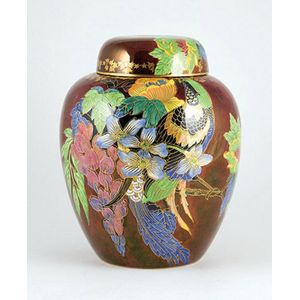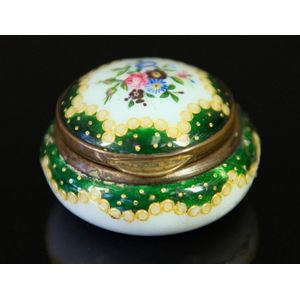"Devil's Copse" Carlton Ware Vase
You must be a subscriber, and be logged in to view price and dealer details.
Subscribe Now to view actual auction price for this item
When you subscribe, you have the option of setting the currency in which to display prices to $Au, $US, $NZ or Stg.
- Attributed - A cataloguing term where the item in the opinion of the cataloguers, is a of the period of the artist, craftsman or designer, and which probably in whole or part is the work of that person.
- Jewelled Decoration - Jewelled decoration on ceramics is a technique where small, colourful, and often metallic beads or "jewels" are applied to the surface of ceramic objects to create intricate and highly decorative designs. This technique has been used throughout history and across different cultures, but it was particularly popular during the late 19th and early 20th centuries, especially in Europe.
The jewelled decoration is usually applied by hand, one bead at a time, onto a base glaze or enamel. The beads can be made of glass, porcelain, or even precious stones, and are often set in a metal setting, such as gold or silver. The end result is a highly decorative and often luxurious surface, which can add a lot of visual interest and value to the ceramic object.
Jewelled decoration was used on a wide range of ceramic objects, including vases, plates, bowls, and figurines. It was particularly popular in the Art Nouveau and Art Deco periods, where it was used to create highly stylized and ornate designs. - Circa - A Latin term meaning 'about', often used in the antique trade to give an approximate date for the piece, usually considered to be five years on either side of the circa year. Thus, circa 1900 means the piece was made about 1900, probably between 1895 and 1905. The expression is sometimes abbreviated to c.1900.
This item has been included into following indexes:
- Carlton Ware (England), item types - vases and ewers 286
- Carlton Ware (England), patterns
- Elmer, Violet, England - Carlton Ware (England), designers 24
Visually similar items

Large Crown Devon Rouge Royale vase and cover ovoid body boldly decorated with exotic bird and florals (crack to cover)

Early circular enamel patch box. Floral decoration on white ground. Possibly 19th century. Diameter 3.50 cm

An 'Egyptian Fan' dish by Carlton Ware, 1932-1933, pattern 3696, 'Revo' bowl shape, design attributed to Violet Elmer, the shaped lozenge dish jewelled and gilded with a stylised arc shaped fan flanked by towers of hollyhock style flowers and other spiral

A Moorcroft 'Orchid' vase, spherical shape on blue ground. Height 10.5 cm.
